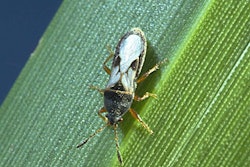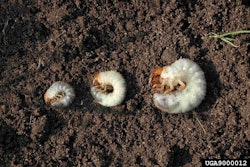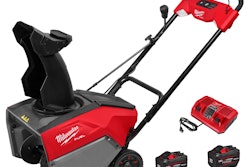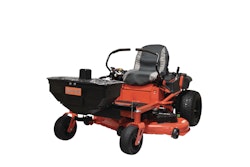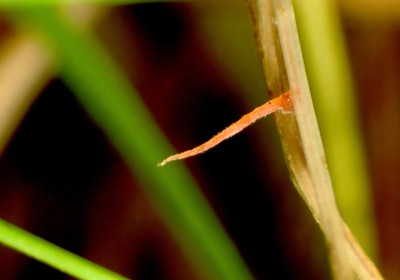 Red thread is one of the most common fungal diseases found on residential lawns.
Red thread is one of the most common fungal diseases found on residential lawns. Photo: Bruce Watt, University of Maine, Bugwood.org
Your biggest turf problem could be a case of mistaken identity.
If your turf isn’t responding to fungicides, it could be that you have 99 problems, but turf disease isn’t one of them.
Turf disease is not the most common problem for residential and commercial properties, which could be why it ranks as one of the most misdiagnosed problems.
There are other more common turf problems that are often mistaken for turf disease, and they can easily lure you down the trail to mistaken identity.
You should be careful that you aren’t lulled into erring in the other direction, either. Turf disease is a very real problem, even on landscape turf.
If you think you have a disease problem and it’s not responding to fungicides, it’s time to troubleshoot. Get a second opinion, reconsider the product you’re using and closely examine your application methods. Following these steps should reveal the real trouble with turf.
Close won’t cut it
The No. 1 reason a fungicide management program isn’t effective: Disease isn’t really the problem.
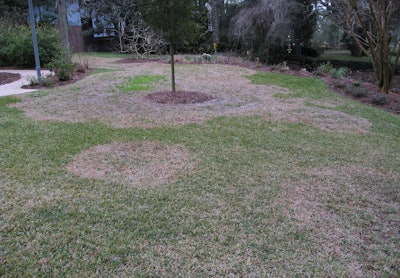 Symptoms of rhizoctonia can come on quickly as rough, circular brown patches.
Symptoms of rhizoctonia can come on quickly as rough, circular brown patches. Photo: Chazz Hesselein, Alabama Cooperative Extension System, Bugwood.org
“Most likely, the disease you are trying to manage has not been properly diagnosed. If your fungicide program is not working, you should contact your nearest turfgrass pathologist and get an appropriate diagnosis,” says Jim Kerns, Ph.D., assistant professor and extension specialist for turfgrass pathology at North Carolina State University. “We rarely see massive disease issues in landscape turf. It’s more likely some abiotic is a problem, like soil type, fertility, etc.”
If a turf problem comes on suddenly, is widespread and severe, that’s a clue that something other than turf disease is causing it and should prompt you to explore other options, according to the University of California Integrated Pest Management Program.
Turf damage that could be mistaken for disease is often caused by heat stress, compaction, fertilizer, water, herbicides, mowing and poor drainage. In fact, the University of California IPM reports irrigation problems are the most common cause of discolored lawns.
Diseases in turf typically start small, with a few spots or patches. If you’ve ruled out other causes for turf decline and are convinced that a disease is the culprit, your next move should be to get a second opinion.
“Get a professional diagnosis if you suspect a disease is problematic,” Kerns says. “Even if it is not a disease, a local extension specialist or turfgrass pathologist will likely be able to help you correct the problem.”
At many universities, you can receive lab result in as little as 24 hours that will pinpoint the problem and provide positive identification.
Product performance
The most overlooked element when selecting a fungicide, according to Kerns, is a basic understanding of the way it works. Ignoring mode of action can make an otherwise great product unsuitable for you.
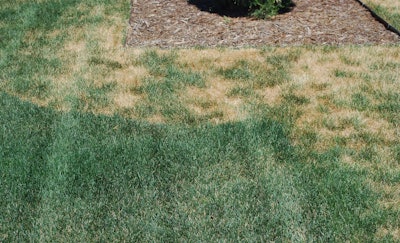 Spring dead spot is a difficult disease to manage. It can recur in the same spot each year.
Spring dead spot is a difficult disease to manage. It can recur in the same spot each year. Photo: Howard F. Schwartz, Colorado State University. Bugwood.org
“Topical mode of action, how the fungicide moves on or within the plant” is a critical component to consider when selecting a product, Kerns says. “This is important because selecting the best product is key but also understanding how the fungicide reacts when it comes into contact with the plant is of paramount importance.”
Contact fungicides provide a broad spectrum of control but do not move appreciably within the plant, staying primarily on the leaf and stem surfaces. This makes them an appropriate choice for foliar diseases. Systemic fungicides are absorbed and translocated within the plant, making them the better choice for diseases of roots and crowns (although they can also be used for foliar diseases).
Having a basic understanding of the modes of action, in combination with a positive identification of the disease, will go a long way in narrowing product selection.
Application aptitude
In the trifecta of disease control, it’s all or nothing. Even if you’ve pinpointed the problem and chosen the most effective product, a misapplication will leave you disappointed, wondering what went wrong.
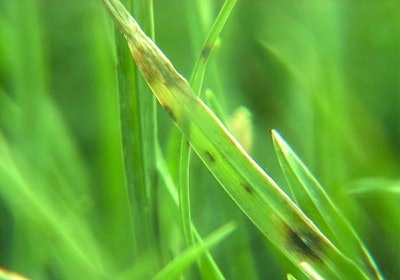 Gray leaf spot threatens turf in wet and humid conditions, especially young perennial ryegrass and tall fescue.
Gray leaf spot threatens turf in wet and humid conditions, especially young perennial ryegrass and tall fescue. Photo: Ned Tisserat, Colorado State University, Bugwood.org
Under- or over-applying a fungicide is a common mistake, Kerns says.
For fungicides to be effective, you must use them at their recommended rates. Double check the rate on the label and be careful you don’t make a mistake in your calculations. The label will usually provide a range of application rates that pertain to using the product preventively or curatively.
“Fungicides can be used on a preventive basis – usually at lower rates and/or at longer intervals between applications – when disease outbreak has not yet occurred but when weather favorable for disease is expected,” says Paul Vincelli, Ph.D., extension professor, plant pathology, the University of Kentucky.
“Conversely, fungicides may be used on a curative basis – often at higher rates and/or at shorter intervals – after an outbreak has occurred and disease pressure is high,” he says.
Cultural control
The best way to deal with turf disease is to discourage it by promoting good cultural practices that result in dense, vigorous turf. Making sure grass is not mowed too short, irrigation is on target and water is draining properly, fertilizer is moderated and thatch is eliminated will promote a healthy turf.
“If a disease does break out, keep in mind a return to weather favorable for turf growth and vigor will help alleviate the problem,” Vincelli says.
Often, a lawn will recover from disease on its own if you’ve been promoting turf health.

